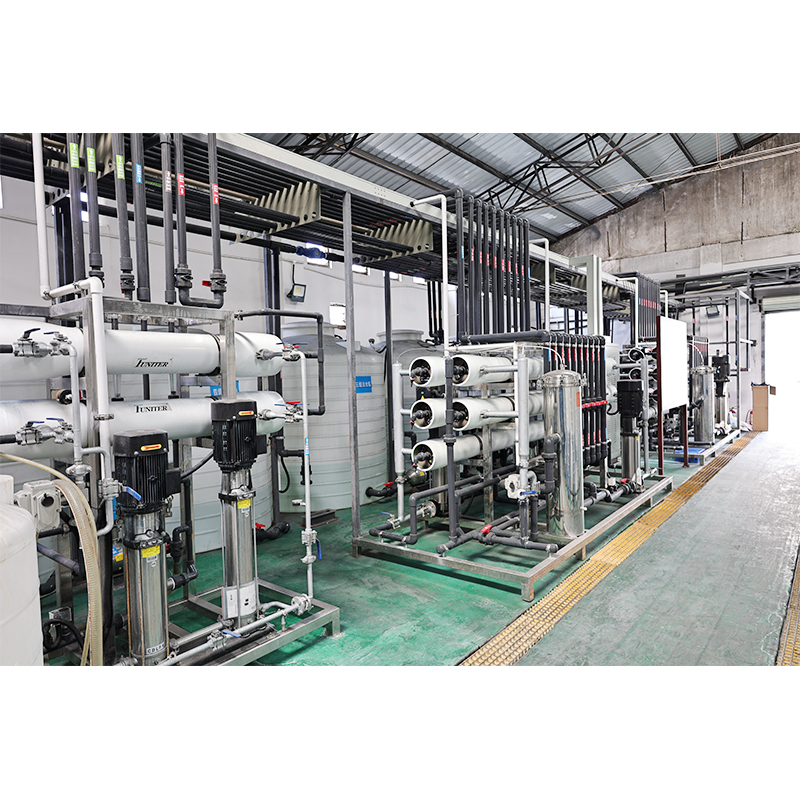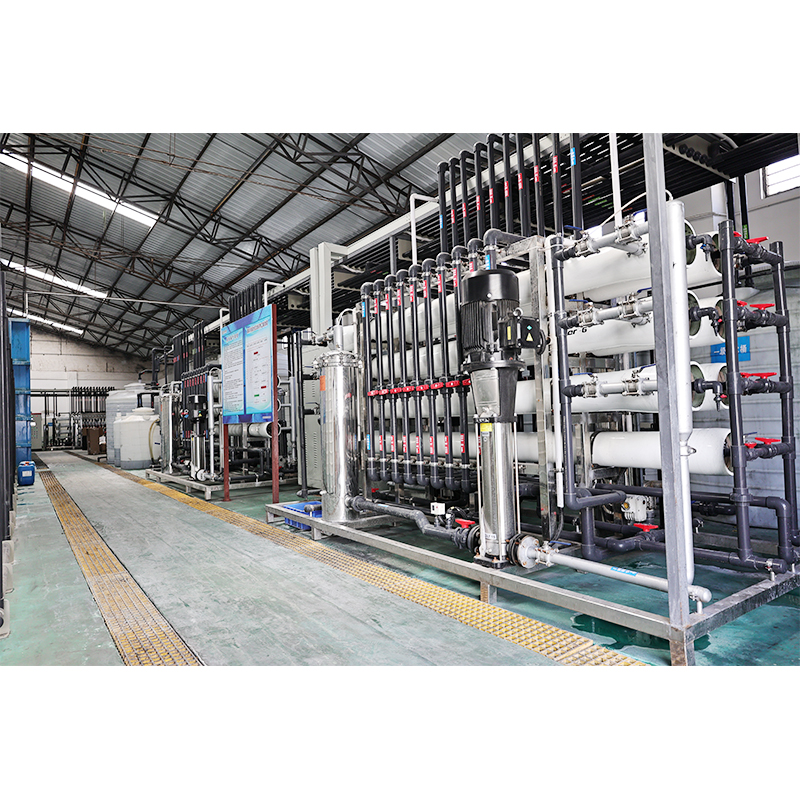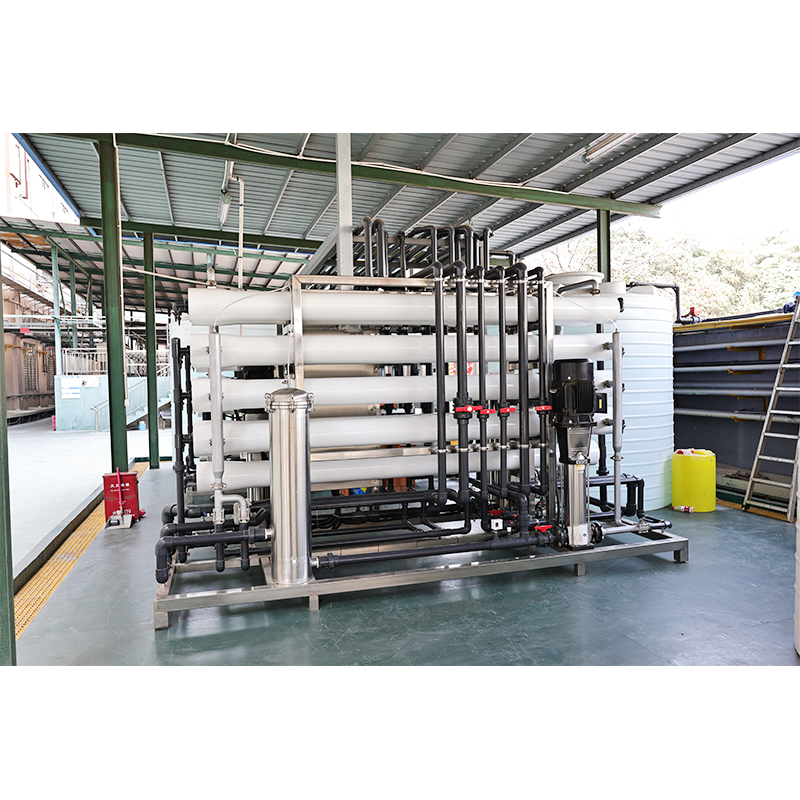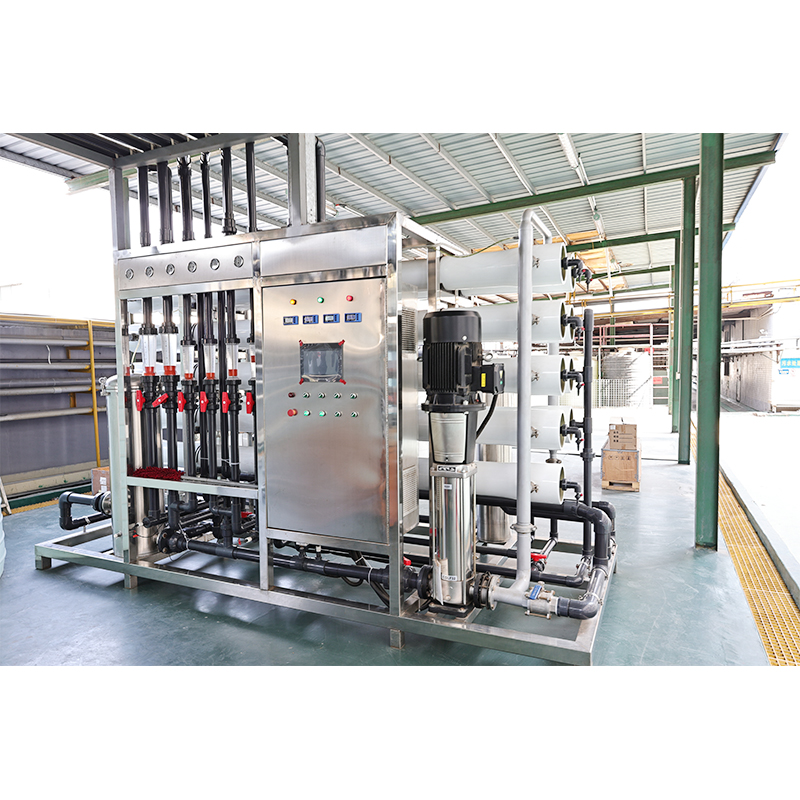How does industrial RO membrane maintain efficient operation when treating high-salinity wastewater?
Release Time : 2025-04-29
The challenges faced by industrial RO membrane in treating high-salinity wastewater mainly focus on maintaining its efficient operation. High-salinity wastewater contains a large amount of dissolved solids and other contaminants, which may have a serious impact on the performance of RO membranes, such as reducing water flux, increasing energy consumption and shortening membrane life. Therefore, taking a series of comprehensive measures to optimize system design, improve operating conditions and strengthen maintenance management is the key to ensure that RO membranes can operate stably and efficiently in the long term.
First of all, it is crucial to fully consider the characteristics of the influent water quality during the system design stage. For high-salinity wastewater, strict pretreatment is usually required to remove potential sources of pollution such as suspended particles, organic matter and hardness ions. Common pretreatment methods include sand filtration, activated carbon adsorption, ultrafiltration and even nanofiltration. These steps can effectively reduce the pollutant load entering the RO system, thereby reducing the risk of contamination on the membrane surface. In addition, the selection of appropriate pretreatment agents, such as scale inhibitors and dispersants, can also prevent scaling substances from depositing on the membrane surface and ensure that the water flow channel is unobstructed. Through scientific and reasonable pretreatment schemes, not only can the working efficiency of RO membranes be improved, but also its service life can be extended and the overall operating cost can be reduced.
Secondly, optimizing the operating parameters of the RO system is also one of the important means to maintain efficient operation. Temperature, pressure and recovery rate are the main factors affecting the performance of RO membranes. Generally speaking, appropriately increasing the operating temperature helps to enhance the selective permeability of water molecules through the membrane, thereby increasing the water flux; however, too high a temperature may accelerate the aging process of the membrane material, so it is necessary to make a trade-off adjustment according to the specific situation. Similarly, applying moderate pressure can promote water penetration, but excessive pressure will not only increase energy consumption, but may also cause damage to the membrane structure or leakage problems. Reasonable control of the recovery rate can avoid the occurrence of concentration polarization, that is, the mass transfer resistance caused by the solute concentration gradient increases, affecting the desalination effect. Practice has proved that by dynamically monitoring and adjusting the above parameters in a timely manner, the best operating state can be achieved while ensuring the quality of the effluent.
Furthermore, for the complex components unique to high-salinity wastewater, the use of advanced membrane technology or combined processes can often achieve twice the result with half the effort. For example, the combination of electrodeionization (EDI) and RO can further purify water and remove trace impurities; or forward osmosis (FO) can be used as a pre-process of RO to drive water transfer using natural osmotic pressure difference, reducing the load pressure of the subsequent RO stage. These innovative integrated solutions can not only significantly improve the processing capacity and stability of the system, but also help to cope with technical difficulties that are difficult to overcome with traditional RO.
In addition, regular cleaning and maintenance of RO membranes are also an indispensable part of maintaining their efficient operation. As the use time increases, various types of dirt, such as biofilm, inorganic salt precipitation and organic residues, will inevitably form on the membrane surface. If not cleaned in time, it will seriously hinder the water flow path and reduce the separation efficiency of the membrane. To this end, it is particularly important to formulate a detailed cleaning plan, select targeted and environmentally friendly cleaning agents, and perform physical cleaning (such as backwashing, air scrubbing) and chemical cleaning procedures according to the prescribed cycle. At the same time, establishing a complete online monitoring system to track the operation status of the membrane in real time and taking corresponding measures immediately once abnormal indicators are found will help prevent major failures and ensure safe and reliable operation of the equipment.
Finally, it is worth noting that with the advancement of science and technology and increasingly stringent environmental protection requirements, the development of new high-performance RO membrane materials has become one of the current research hotspots. New membrane materials have higher selectivity and anti-pollution ability, and can maintain excellent filtration performance under harsh environments. For example, cutting-edge achievements such as nanocomposite membranes, self-healing membranes, and modified membranes with special functional layers continue to emerge, providing new ideas and technical support for solving the problem of high-salinity wastewater treatment. Enterprises should pay close attention to the latest developments in the industry, actively introduce advanced technologies and products, and continuously improve their competitiveness.
In summary, through careful design of pretreatment systems, optimization of operating parameters, application of advanced membrane technology, and strengthening of daily maintenance and other efforts, the adverse effects of high-salinity wastewater on RO membranes can be effectively overcome to ensure that they always maintain efficient and stable operation. This not only helps to improve the utilization rate of water resources and reduce environmental pollution, but also lays a solid foundation for the sustainable development of related industries. In this process, continuous technological innovation and perfect service experience will be the key to success. Through continuous exploration and practice, we believe that the future industrial ro membrane technology will be more intelligent and efficient, bringing greater value to various high-difficulty sewage treatment projects. Whether it is professional users pursuing high quality or enterprises focusing on cost-effectiveness, they will benefit from it and enjoy unprecedented high-quality service experience.
First of all, it is crucial to fully consider the characteristics of the influent water quality during the system design stage. For high-salinity wastewater, strict pretreatment is usually required to remove potential sources of pollution such as suspended particles, organic matter and hardness ions. Common pretreatment methods include sand filtration, activated carbon adsorption, ultrafiltration and even nanofiltration. These steps can effectively reduce the pollutant load entering the RO system, thereby reducing the risk of contamination on the membrane surface. In addition, the selection of appropriate pretreatment agents, such as scale inhibitors and dispersants, can also prevent scaling substances from depositing on the membrane surface and ensure that the water flow channel is unobstructed. Through scientific and reasonable pretreatment schemes, not only can the working efficiency of RO membranes be improved, but also its service life can be extended and the overall operating cost can be reduced.
Secondly, optimizing the operating parameters of the RO system is also one of the important means to maintain efficient operation. Temperature, pressure and recovery rate are the main factors affecting the performance of RO membranes. Generally speaking, appropriately increasing the operating temperature helps to enhance the selective permeability of water molecules through the membrane, thereby increasing the water flux; however, too high a temperature may accelerate the aging process of the membrane material, so it is necessary to make a trade-off adjustment according to the specific situation. Similarly, applying moderate pressure can promote water penetration, but excessive pressure will not only increase energy consumption, but may also cause damage to the membrane structure or leakage problems. Reasonable control of the recovery rate can avoid the occurrence of concentration polarization, that is, the mass transfer resistance caused by the solute concentration gradient increases, affecting the desalination effect. Practice has proved that by dynamically monitoring and adjusting the above parameters in a timely manner, the best operating state can be achieved while ensuring the quality of the effluent.
Furthermore, for the complex components unique to high-salinity wastewater, the use of advanced membrane technology or combined processes can often achieve twice the result with half the effort. For example, the combination of electrodeionization (EDI) and RO can further purify water and remove trace impurities; or forward osmosis (FO) can be used as a pre-process of RO to drive water transfer using natural osmotic pressure difference, reducing the load pressure of the subsequent RO stage. These innovative integrated solutions can not only significantly improve the processing capacity and stability of the system, but also help to cope with technical difficulties that are difficult to overcome with traditional RO.
In addition, regular cleaning and maintenance of RO membranes are also an indispensable part of maintaining their efficient operation. As the use time increases, various types of dirt, such as biofilm, inorganic salt precipitation and organic residues, will inevitably form on the membrane surface. If not cleaned in time, it will seriously hinder the water flow path and reduce the separation efficiency of the membrane. To this end, it is particularly important to formulate a detailed cleaning plan, select targeted and environmentally friendly cleaning agents, and perform physical cleaning (such as backwashing, air scrubbing) and chemical cleaning procedures according to the prescribed cycle. At the same time, establishing a complete online monitoring system to track the operation status of the membrane in real time and taking corresponding measures immediately once abnormal indicators are found will help prevent major failures and ensure safe and reliable operation of the equipment.
Finally, it is worth noting that with the advancement of science and technology and increasingly stringent environmental protection requirements, the development of new high-performance RO membrane materials has become one of the current research hotspots. New membrane materials have higher selectivity and anti-pollution ability, and can maintain excellent filtration performance under harsh environments. For example, cutting-edge achievements such as nanocomposite membranes, self-healing membranes, and modified membranes with special functional layers continue to emerge, providing new ideas and technical support for solving the problem of high-salinity wastewater treatment. Enterprises should pay close attention to the latest developments in the industry, actively introduce advanced technologies and products, and continuously improve their competitiveness.
In summary, through careful design of pretreatment systems, optimization of operating parameters, application of advanced membrane technology, and strengthening of daily maintenance and other efforts, the adverse effects of high-salinity wastewater on RO membranes can be effectively overcome to ensure that they always maintain efficient and stable operation. This not only helps to improve the utilization rate of water resources and reduce environmental pollution, but also lays a solid foundation for the sustainable development of related industries. In this process, continuous technological innovation and perfect service experience will be the key to success. Through continuous exploration and practice, we believe that the future industrial ro membrane technology will be more intelligent and efficient, bringing greater value to various high-difficulty sewage treatment projects. Whether it is professional users pursuing high quality or enterprises focusing on cost-effectiveness, they will benefit from it and enjoy unprecedented high-quality service experience.







